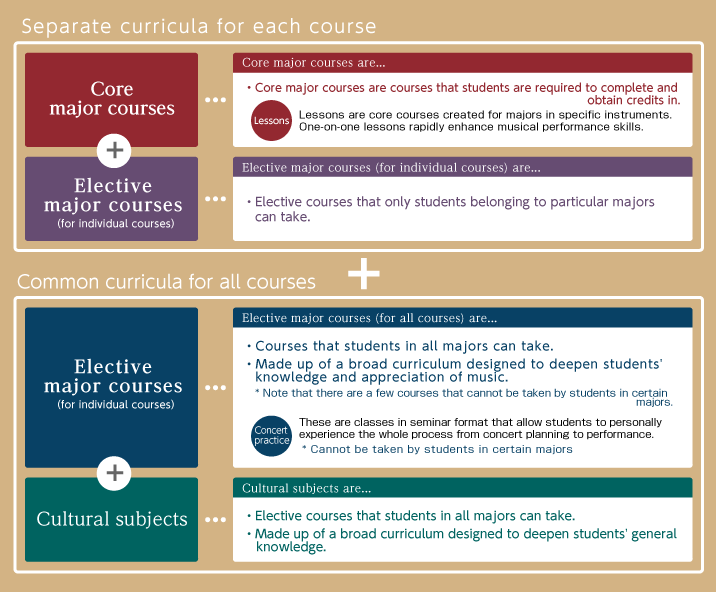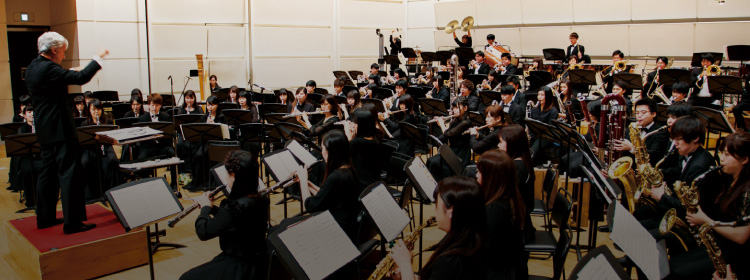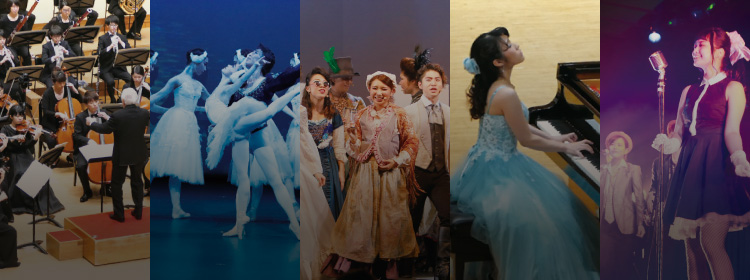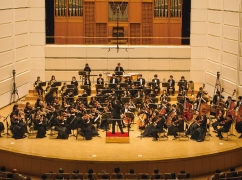Divers Range of Courses and Substantial Curriculum

Diverse range of courses with practical skills and exercises at the core
Contents of the education provided by courses in the program of study for the bachelor’s degree feature practical skills and exercises with the purposes and objectives of education being fundamental theory of music, basic performance techniques and expressive techniques. Specific courses consist of lessons provided by courses entitled “XX Performance method Research”, as well as such courses as “Concert Practical Training”, “Chamber Music Research” or “Orchestra Research”. The primary courses offer cores for studying music, such as “Solfège”, “harmonics ” or “counterpoint ” that are necessary as background knowledge for studying such performance techniques and expressive techniques. Such primary courses form the framework of many elective courses and liberal arts courses that nurture deeper understanding of music and rich musical expressions. Avenues to study various foreign languages are obviously provided but such courses as “Music History”, “History of Western Culture” and “Economy” are also featured in order to nurture the ability to see things from a comprehensive perspective.
Finely graduated courses that correspond to current levels of individual students
Many music related courses have adopted the graduated system. Setting finely graduated levels for courses allows students to start their study from the level that is suitable for them. Prerequisites are established for courses that go up in levels as the years progress, through such means as setting prerequisite courses to ensure that students acquire deeper understanding. 
Creating environment for autonomous study of music with “free thought and free selections”
Classes are broadly categorized into “Required Courses for Specialization”, “Elective Courses for Specialization” (for respective programs of study), “Elective Courses for Specialization” (common for all programs) and “Liberal Arts Courses”. The main characteristics of programs offered is that the academic units for“Required Courses”are reduced and a large number of electable courses are provided as students are encouraged to think for themselves “what they want to become” and “what classes must be taken to achieve that” and select the curriculum that best suits the objectives of individual students. Making selections based on their own decisions towards their own objectives over and over again forms the attitude of each individual students taking charge of their own learning. Establishing an environment for learning music with free thought allows students to encounter music and knowledge of various genres that are from outside their own specialization. This makes it possible for students to gain culture with a broad perspective.
Drawing out individuality and creativity of each individual person aspiring to study music
Each student must complete a prescribed number of classes for respective programs to earn “credits”. Students decide on courses they complete from among available classes, set up their schedule and earn units required for graduation.
Structure of curriculum
A student must earn a total of at least 124 credits while registered as a student for the prescribed number of years (ordinarily four years) in order to complete the program of study and graduate from the University. The major characteristic here is that each student may freely assemble a curriculum to suit their individual interests and aspirations. 
Concert classes that span across boundaries of programs

Concert classes that nurture abundant musical expressions
The number and abundance of contents without question symbolize the concert classes available at the University. Students may be bewildered with available selections as concert organizations of diverse and varied types exist at the University, but each of these classes are led by principal instructor and a team of superior instructors, with not only instructions but also total support in practical skills aspects also for performance. Another characteristic is the holding of concerts under famous conductors that are invited from within Japan as well as overseas. Many invaluable experiences will be amassed under guidance of first class conductors.
-
Orchestras
Students may take part in three modes of orchestras, according to their abilities.
- Basic Orchestra
- This is an orchestra intended for first year student of the Wind, String and Percussion Musical Instrument Program. Performances are conducted through separated and combined performance with basic musical pieces as topics.
- Repertoire Orchestras
- Students engage in research and practical performance culminating in a concert, while studying orchestra studies. Members are selected based on academic performance of academic year final exams from among applicants from second and third year wind and percussion instruments who desire to take the course.
- Master Orchestra (Senzoku Gakuen College of Music Philharmonic Orchestra)
- This is the apex of orchestral performance at Senzoku, with training conducted that culminate in a variety of concerts. Members are selected based on academic performance of academic year final exams from among applicants from second to fourth year wind, string and percussion instruments who desire to take the course.
-
Wind Instrument Music
There are four brass bands at Senzoku, with students taking part according to individual compatibility.
- Senzoku Wind Symphony
- This is the flagship band of Senzoku,capturing audiences through various concerts.
- Blue Tie
- The band pursues clear sound as a wind ensemble. The band participated in the Midwest Clinic in 2012.
- Green Tie
- The band is engaged in extensive interchange with Wind Ensemble Asian and has a broad fan base overseas.
- Freshman Wind Ensemble
- The band is comprised by freshman students only. The band nurtures the sense of solidarity while promoting drive for improvements and trains students to acquire basics of concert performance and expressive abilities.
-
Chamber Music
A broad range of chamber music pieces that range from classical to modern are experienced to train techniques of students.
- Fundamentals of chamber music are learned as a class during the first year.
- Teams are formed from the second year for a fully fledged learning of the chamber music.
-
Ensemble
Unique styles are formulated through concert lessons comprised by combining a variety of musical instruments.
- Guitar Ensemble
- Practical training for ensemble with guitars of various sound ranges are provided to nurture the ability of students to perform in ensembles.
- British Brass
- This is a British style brass band with trombone and percussion instruments added to the troop of saxhorns
- Fanfare Orchestra
- This is a concert mode popular primarily in the Netherlands and Belgium.
- Seonzoku String Orchestra
- Ear to hear the sound of other musical instruments and voice is nurtured while aiming to become capable of performing without a conductor.
- Percussion Instrument Ensemble
- Performance methods of a diverse range and various percussion instruments are learned, using a variety of music pieces.
- Saxophone Orchestra
- Eight types of saxophones ranging from superior to contrabass are gathered together with percussion instruments to form the orchestra. The group aims for musical expression of higher grades.
- Flute Orchestra
- Flutes of the same type are gathered to form the orchestra. The orchestra is not limited to playing original pieces but music pieces from a wide range of fields are also selected.
Concerts given in excess of 200 times annually

Art management learned from actual work
In excess of 200 concerts are held by Senzoku Gakuen College of Music each year. Teaching faculty involved with the role of supporting such concerts are the Academic Coordinators. Performing students are involved in the production of concerts under guidance of these coordinators. Know-how needed for their performance activities in the future, ranging from production of printed materials to public relations are leaned through this experience. All concert organizations support each others during the period of the Winter Music Festival, the time of the year in which a large number of concerts are held, and accumulate their experience. Students learn about art management for concerts through such practical work.
Representative concerts

Scheduled Concert of Philharmonic Orchestra
Saxophone Orchestra
“Evening of Piano Concerto” through collaborative performance with electronic organ
Broadway musical “Into the Woods”
Japanese musical “Natsu Hanabi Koi Nagori” (Reminder of Love from Summer Firework Festival)
Scheduled Concert of Fanfare Orchestra
Opera Trial Performance
World Heritage of Rock and Pops
Seonzoku String Orchestra Concert
Ballet “Swan Lake”